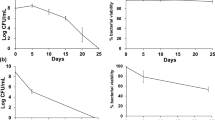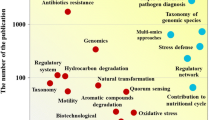Abstract
Through our previous study, we found an up-regulation in the expression of nitrite reductase (nirS) in the isothiazolone-resistant strain of Pseudomonas aeruginosa. However, the definitive molecular role of nirS in ascribing the resistance remained elusive. In the present study, the nirS gene was deleted from the chromosome of P. aeruginosa ATCC 9027 and the resulting phenotypic changes of ΔnirS were studied alongside the wild-type (WT) strain under aerobic conditions. The results demonstrated a decline in the formations of biofilms but not planktonic growth by ΔnirS as compared to WT, especially in the presence of benzisothiazolinone (BIT). Meanwhile, the deletion of nirS impaired swimming motility of P. aeruginosa under the stress of BIT. To assess the influence of nirS on the transcriptome of P. aeruginosa, RNA-seq experiments comparing the ΔnirS with WT were also performed. A total of 694 genes were found to be differentially expressed in ΔnirS, of which 192 were up-regulated, while 502 were down-regulated. In addition, these differently expressed genes were noted to significantly enrich the carbon metabolism along with glyoxylate and dicarboxylate metabolisms. Meanwhile, results from RT-PCR suggested the contribution of mexEF-oprN to the development of BIT resistance by ΔnirS. Further, c-di-GMP was less in ΔnirS than in WT, as revealed by HPLC. Taken together, our results confirm that nirS of P. aeruginosa ATCC 9027 plays a role in BIT resistance along with biofilm formation and further affects several metabolic patterns under aerobic conditions.






Similar content being viewed by others
References
Arai H, Kodama T, Igarashi Y (1999) Effect of nitrogen oxides on expression of the nir and nor genes for denitrification in Pseudomonas aeruginosa. FEMS Microbiol Lett 170:19–24
Barraud N, Hassett DJ, Hwang S-H, Rice SA, Kjelleberg S, Webb JS (2006) Involvement of nitric oxide in biofilm dispersal of Pseudomonas aeruginosa. J Bacteriol 188:7344–7353
Barraud N, Schleheck D, Klebensberger J, Webb JS, Hassett DJ, Rice SA, Kjelleberg S (2009) Nitric oxide signaling in Pseudomonas aeruginosa biofilms mediates phosphodiesterase activity, decreased cyclic Di-GMP levels, and enhanced dispersal. J Bacteriol 191:7333–7342
Chapman JS (2003) Biocide resistance mechanisms. Int Biodeterior Biodegrad 51:133–138
Chapman JS, Diehl MA (1995) Methylchloroisothiazolone-induced growth inhibition and lethality in Escherichia coli. J Appl Microbiol 78:134–141
Chen YC, Xie XB, Shi QS, Ouyang YS, Chen YB (2010) Species identification of industry spoilage microorganism and the resistance analysis. Microbiol China 37:1558–1565
Chuanchuen R, Beinlich K, Hoang TT, Becher A, Karkhoff-Schweizer RR, Schweizer HP (2001) Cross-resistance between triclosan and antibiotics in Pseudomonas aeruginosa is mediated by multidrug efflux pumps: exposure of a susceptible mutant strain to triclosan selects nfxB mutants overexpressing MexCD-OprJ. Antimicrob Agents Chemother 45:428–432
Davies KJP, Lloyd D, Boddy L (1989) The effect of oxygen on denitrification in Paracoccus denitrificans and Pseudomonas aeruginosa. Microbiology 135:2445–2451
De Kievit TR, Parkins MD, Gillis RJ, Srikumar R, Ceri H, Poole K, Iglewski BH, Storey DG (2001) Multidrug efflux pumps: expression patterns and contribution to antibiotic resistance in Pseudomonas aeruginosa biofilms. Antimicrob Agents Chemother 45:1761–1770
Drenkard E (2003) Antimicrobial resistance of Pseudomonas aeruginosa biofilms. Microbes Infect 5:1213–1219
Germ M, Yoshihara E, Yoneyama H, Nakae T (1999) Interplay between the efflux pump and the outer membrane permeability barrier in fluorescent dye accumulation in Pseudomonas aeruginosa. Biochem Biophys Res Commun 261:452–455
Hancock RE (1998) Resistance mechanisms in Pseudomonas aeruginosa and other non-fermentative gram-negative bacteria. Clin Infect Dis 27:S93–S99
Huang CY, Hsieh SP, Kuo PA, Jane WN, Tu J, Wang YN, Ko CH (2009) Impact of disinfectant and nutrient concentration on growth and biofilm formation for a Pseudomonas strain and the mixed cultures from a fine papermachine system. Int Biodeterior Biodegrad 63:998–1007
Huang YH, Lin JS, Ma JC, Wang HH (2016) Functional characterization of triclosan-resistant enoyl-acyl-carrier protein reductase (FabV) in Pseudomonas aeruginosa. Front Microbiol 7:1903
Su JJ, Liu BY, Liu CY (2001) Comparison of aerobic denitrification under high oxygen atmosphere by Thiosphaera pantotropha ATCC 35512 and Pseudomonas stutzeri SU2 newly isolated from the activated sludge of a piggery wastewater treatment system. J Appl Microbiol 90:457–462
Köhler T, Michea-Hamzehpour M, Plesiat P, Kahr A-L, Pechere J-C (1997) Differential selection of multidrug efflux systems by quinolones in Pseudomonas aeruginosa. Antimicrob Agents Chemother 41:2540–2543
Kohler T, Michea-Hamzehpour M, Henze U, Gotoh N, Curty LK, Pechere JC (1997) Characterization of MexE-MexF-OprN, a positively regulated multidrug efflux system of Pseudomonas aeruginosa. Mol Microbiol 23:345–354
Krüger A, Grüning N-M, Wamelink MM, Kerick M, Kirpy A, Parkhomchuk D, Bluemlein K, Schweiger M-R, Soldatov A, Lehrach H (2011) The pentose phosphate pathway is a metabolic redox sensor and regulates transcription during the antioxidant response. Antioxid Redox Signal 15:311–324
Lambert P (2002) Mechanisms of antibiotic resistance in Pseudomonas aeruginosa. J R Soc Med 95:22–26
Laopaiboon L, Smith RN, Hall SJ (2001) A study of the effect of isothiazolones on the performance and characteristics of a laboratory-scale rotating biological contactor. J Appl Microbiol 91:93–103
Li XZ, Zhang L, Poole K (1998) Role of the multidrug efflux systems of Pseudomonas aeruginosa in organic solvent tolerance. J Bacteriol 180:2987–2991
Livak KJ, Schmittgen TD (2001) Analysis of relative gene expression data using real-time quantitative PCR and the 2−ΔΔCt method. Methods 25:402–408
Lyczak JB, Cannon CL, Pier GB (2000) Establishment of Pseudomonas aeruginosa infection: lessons from a versatile opportunist. Microbes Infect 2:1051–1060
Lyczak JB, Cannon CL, Pier GB (2002) Lung infections associated with cystic fibrosis. Clin Microbiol Rev 15:194–222
Ma JC, Wu YQ, Cao D, Zhang WB, Wang HH (2017) Only acyl carrier protein 1 (AcpP1) functions in Pseudomonas aeruginosa fatty acid synthesis. Front Microbiol 8:2186
Morita Y, Tomida J, Kawamura Y (2014) Responses of Pseudomonas aeruginosa to antimicrobials. Front Microbiol 4:422
O’Toole G, Kaplan HB, Kolter R (2000) Biofilm formation as microbial development. Annu Rev Microbiol 54:49–79
Poole K (2011) Pseudomonas aeruginosa: resistance to the max. Front Microbiol 2:65
Pucci MJ, Podos SD, Thanassi JA, Leggio MJ, Bradbury BJ, Deshpande M (2011) In vitro and in vivo profiles of ACH-702, an isothiazoloquinolone, against bacterial pathogens. Antimicrob Agents Chemother 55:2860–2871
Römling U, Galperin MY, Gomelsky M (2013) Cyclic di-GMP: the first 25 years of a universal bacterial second messenger. Microbiol Mol Biol Rev 77:1–52
Rashid MH, Kornberg A (2000) Inorganic polyphosphate is needed for swimming, swarming, and twitching motilities of Pseudomonas aeruginosa. Proc Natl Acad Sci USA 97:4885–4890
Rinaldo S, Giardina G, Castiglione N, Stelitano V, Cutruzzola F (2011) The catalytic mechanism of Pseudomonas aeruginosa cd(1) nitrite reductase. Biochem Soc T 39:195–200
Robinson MD, Oshlack A (2010) A scaling normalization method for differential expression analysis of RNA-seq data. Genome Biol 11:R25–R25
Roy AB, Petrova OE, Sauer K (2013) Extraction and quantification of cyclic di-GMP from P. aeruginosa. Bio Protoc 3:e828
Ryan RP, Lucey J, O’Donovan K, McCarthy Y, Yang L, Tolker-Nielsen T, Dow JM (2009) HD-GYP domain proteins regulate biofilm formation and virulence in Pseudomonas aeruginosa. Environ Microbiol 11:1126–1136
Sandoe JAT, Wysome J, West AP, Heritage J, Wilcox MH (2006) Measurement of ampicillin, vancomycin, linezolid and gentamicin activity against enterococcal biofilms. J Antimicrob Chemother 57:767–770
Silvestrini MC, Galeotti CL, Gervais M, Schininà E, Barra D, Bossa F, Brunori M (1989) Nitrite reductase from Pseudomonas aeruginosa: sequence of the gene and the protein. FEBS Lett 254:33–38
Singh PK, Schaefer AL, Parsek MR, Moninger TO, Welsh MJ, Greenberg E (2000) Quorum-sensing signals indicate that cystic fibrosis lungs are infected with bacterial biofilms. Nature 407:762–764
Stepanović S, Vuković D, Dakić I, Savić B, Švabić-Vlahović M (2000) A modified microtiter-plate test for quantification of staphylococcal biofilm formation. J Microbiol Methods 40:175–179
Su S, Panmanee W, Wilson JJ, Mahtani HK, Li Q, VanderWielen BD, Makris TM, Rogers M, McDaniel C, Lipscomb JD, Irvin RT, Schurr MJ, Lancaster JR, Kovall RA, Hassett DJ (2014) Catalase (KatA) plays a role in protection against anaerobic nitric oxide in Pseudomonas aeruginosa. PLoS One 9:e91813
Tang QY, Feng MG (2007) DPS data processing system: experimental design, statistical analysis and data mining. Science Press, Beijing
Vicentini CB, Romagnoli C, Manfredini S, Rossi D, Mares D (2011) Pyrazolo [3,4-c] isothiazole and isothiazolo [4,3-d] isoxazole derivatives as antifungal agents. Pharm Biol 49:545–552
Williams TM (2007) The mechanism of action of isothiazolone biocide. Power Plant Chem 9:14–22
Zhou G, Li LJ, Shi QS, Ouyang YS, Chen YB, Hu WF (2013) Effects of nutritional and environmental conditions on planktonic growth and biofilm formation for Citrobacter werkmanii BF-6. J Microbiol Biotechnol 23:1673–1682
Zhou G, Li LJ, Shi QS, Ouyang YS, Chen YB, Hu WF (2014) Efficacy of metal ions and isothiazolones in inhibiting Enterobacter cloacae BF-17 biofilm formation. Can J Microbiol 60:5–14
Zhou G, Shi QS, Huang XM, Xie XB (2016) Comparison of transcriptomes of wild-type and isothiazolone-resistant Pseudomonas aeruginosa by using RNA-seq. Mol Biol Rep 43:527–540
Zhou G, Shi QS, Ouyang YS, Chen YB (2014) Involvement of outer membrane proteins and peroxide-sensor genes in Burkholderia cepacia resistance to isothiazolone. World J Microbiol Biotechnol 30:1251–1260
Zumft WG (1997) Cell biology and molecular basis of denitrification. Microbiol Mol Biol Rev 61:533–616
Acknowledgements
This work was funded by the GDAS’ Project of Science and Technology Development (No. 2019GDASYL-0104006), the National Natural Science Foundation of China (Nos. 31770091 and 31500036), and Natural Science Foundation of Guangdong Province (No. 2015A030313713). We are grateful to Prof. Hai-hong Wang of South China Agricultural University for generously providing us the plasmids of pK18-GM and pSRK-GM.
Author information
Authors and Affiliations
Corresponding authors
Ethics declarations
Conflict of interest
The authors declare that they have no conflicts of interest.
Additional information
Publisher's Note
Springer Nature remains neutral with regard to jurisdictional claims in published maps and institutional affiliations.
Electronic supplementary material
Below is the link to the electronic supplementary material.
Additional file 1.
Detection of differently expressed genes between WT and ΔnirS transcriptomes using RNA-seq technique. Differences with FDR ≤ 0.05 and log2FC absolute value ≥ 1 were set as the threshold for significant differences in gene expression. (XLS 767 kb)
Rights and permissions
About this article
Cite this article
Zhou, G., Peng, H., Wang, Ys. et al. Biological functions of nirS in Pseudomonas aeruginosa ATCC 9027 under aerobic conditions. J Ind Microbiol Biotechnol 46, 1757–1768 (2019). https://doi.org/10.1007/s10295-019-02232-z
Received:
Accepted:
Published:
Issue Date:
DOI: https://doi.org/10.1007/s10295-019-02232-z




